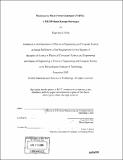Piezoelectric Micro Power Generator (PMPG) : a MEMS-based energy scavenger
Author(s)
Sood, Rajendra K. (Rajendra Kumar), 1979-
DownloadFull printable version (11.70Mb)
Alternative title
PMPG : a microelectromechanical system-based energy scavenger
Other Contributors
Massachusetts Institute of Technology. Dept. of Electrical Engineering and Computer Science.
Advisor
Sang-Gook Kim.
Terms of use
Metadata
Show full item recordAbstract
As MEMS and smart material technologies begin to mature, their applications, such as medical implants and wireless communications are becoming more attractive. Traditionally, remote devices have used chemical batteries to supply their energy. However, batteries are no longer suitable for many of these remote applications due to their relatively large bulk and weight, limited lifetime and high cost. The commercially sponsored Auto ID tag has demonstrated the need for a power source with the characteristics of our Piezoelectric Micro Power Generator (PMPG). The PMPG is a MEMS-based energy scavenging device which converts ambient, vibrational energy into electrical energy. It consists of a composite micro-cantilever beam with a PZT piezoelectric thin film layer and a top, interdigitated electrode structure which exploits the d₃₃ mode of the piezoelectric. When excited into mechanical resonance, the PMPG acts as a current generator whose charge can be stored by an electrical charge storage system. A single PMPG device delivered more than 1 [micro]W of DC power at 2.36 V DC to an electrical load from an ambient, vibrational energy source. The corresponding energy density is approximately 0.74 mW-h/cm2, which compares favorably to competing lithium ion battery solutions for the Auto ID tag. The PMPG power system has an electrical efficiency greater than 99%. In the near future the PMPG power system will serve as the power source for the Auto ID tag and has benefits over its competitors. Namely, the PMPG has a potentially infinite lifetime, is a cheaper, less bulky power solution versus competing lithium ion batteries, and should prove to have a better packaging scheme.
Description
Thesis (M. Eng.)--Massachusetts Institute of Technology, Dept. of Electrical Engineering and Computer Science, 2003. Includes bibliographical references (p. 99-100).
Date issued
2003Department
Massachusetts Institute of Technology. Department of Electrical Engineering and Computer SciencePublisher
Massachusetts Institute of Technology
Keywords
Electrical Engineering and Computer Science.